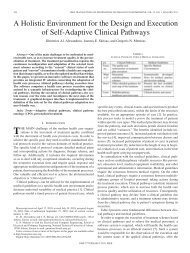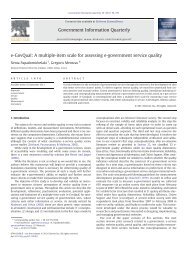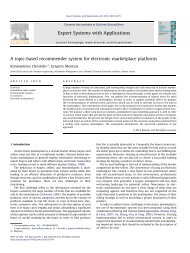Ontology-Based Competency Management for Corporate E-Learning
Ontology-Based Competency Management for Corporate E-Learning
Ontology-Based Competency Management for Corporate E-Learning
Create successful ePaper yourself
Turn your PDF publications into a flip-book with our unique Google optimized e-Paper software.
<strong>Ontology</strong>-<strong>Based</strong> <strong>Competency</strong> <strong>Management</strong> <strong>for</strong> <strong>Corporate</strong> E-<strong>Learning</strong> 323<br />
• Ensure fair employee competency assessment: The correct assessment of the competencies<br />
and competency levels of the employees is crucial to the adoption, usage<br />
and success of the system. Unless the employees feel that their competencies have<br />
been fairly assessed, they will not accept to proceed with the other functions of the<br />
system, such as completing the personalized learning path or succession planning.<br />
As described above, a combination of 360-degree feedback and per<strong>for</strong>mance review<br />
may prove important to the fulfillment of this goal.<br />
Conclusion and Further Research<br />
In this chapter, we have provided a practical approach to the integration of competency<br />
management, e-learning, and ontologies, presenting a system currently under deployment<br />
in a multinational IT firm. The system design and architecture have been analyzed, as well<br />
as the main lessons learned during the design and deployment phase. These include both<br />
technical issues, such as designing <strong>for</strong> integration, making use of visualization components,<br />
and involving the IT department, as well as organizational issues, such as ensuring top executives’<br />
endorsement and ensuring a fair assessment of employees’ skills. Moreover, we<br />
have provided our own approach to the definition of the term “competency” and a further<br />
analysis of its main concepts.<br />
Further research lies in the area of expanding the system with semantic attributes, such as<br />
adding semantic annotation to the Web services exported, in order to enable it with broader<br />
integration capabilities with other ontology-based human resources systems. Moreover,<br />
by adding semantic Web services capabilities to the system, we will enable semantic Web<br />
matchmakers to accept the descriptions of our available services and match them against<br />
requirements from different requestors, in an automatic way. This process can currently be<br />
deployed manually, through registering the produced Web services to universal description,<br />
discovery, and integration directory (UDDI). Additionally, all the data that will have<br />
been gathered upon the completion of its pilot phase deployment in Microsoft Hellas will<br />
be carefully examined in order to reveal trends in the relationships of employees and competencies.<br />
References<br />
Colucci, Di Noia, Di Sciascio, Mongiello, Donini, & Mottola. (2003, July 2-4). Finding<br />
skills through ranked semantic match of descriptions. In Proceedings of I-KNOW<br />
’03: 3 rd International Conference on Knowledge <strong>Management</strong>, Skills <strong>Management</strong>,<br />
Graz, Austria.<br />
Draganidis, F., & Mentzas, G. (in press). <strong>Competency</strong> management: A review of systems<br />
and approaches, International Journal of In<strong>for</strong>mation <strong>Management</strong> and Computer<br />
Security.<br />
Copyright © 2007, Idea Group Inc. Copying or distributing in print or electronic <strong>for</strong>ms without written permission<br />
of Idea Group Inc. is prohibited.





